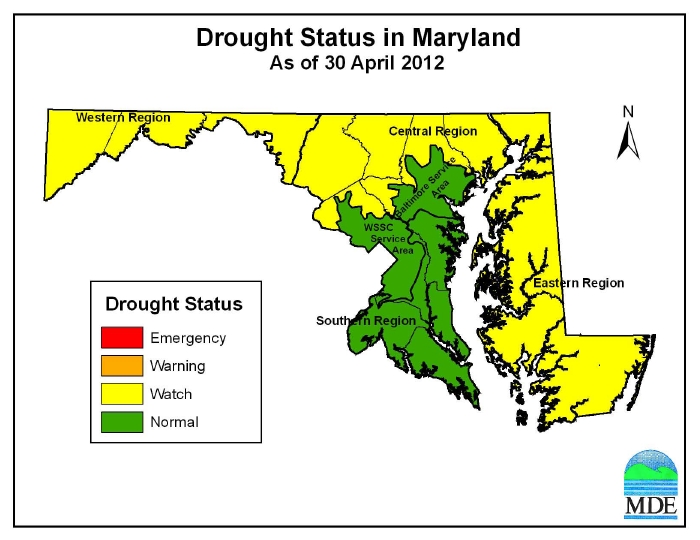BALTIMORE, MD (May 8, 2012) – The Maryland Department of the Environment announced today that a drought “watch” is in effect for the Western and Central regions of Maryland. The previously announced drought watch for the Eastern region of Maryland also remains in effect.
The newly announced drought watch is for Garrett, Allegany, Washington, Frederick, Carroll, Harford and Cecil counties, along with the portions of Montgomery, Howard and Baltimore counties that are not served by the Baltimore City or Washington Suburban Sanitary Commission public water systems. The Eastern region includes Kent County and all counties farther south on the Eastern Shore.
Average precipitation across the state was about 64 percent of normal for the first four months of the year. Stream flow and groundwater levels are below normal through much of the state.
Reservoirs are at or near capacity. Baltimore City and areas of Montgomery, Prince George’s, Howard, Anne Arundel and Baltimore counties that are served by the Baltimore City or Washington Suburban Sanitary Commission public water systems remain in normal status. The Southern region also remains in normal status.
During a drought watch, MDE increases oversight of water supply conditions and encourages citizens to become more aware of their water use and to conserve water. Local water systems can require water-use restrictions at any time due to local conditions, but MDE is not at this time aware of any local jurisdictions implementing voluntary or mandatory restrictions.
MDE monitors precipitation, stream flow, groundwater levels and reservoir storage to determine the drought status for each of six regions of the state. If two or more of the four indicators for a region reach "watch," "warning," or "emergency" levels, then the region is placed in the corresponding status.
Recommended actions have been established for each drought status. Actions recommended for watch stage include:
-
Public awareness and education
-
MDE and water systems provide the public with water conservation tips
-
Water systems aggressively pursue leak detection
-
Reduced water usage for main flushing, street flushing and park irrigation
- Homeowners, government facilities, businesses and industry should reduce water use for irrigation
During the watch stage, MDE will evaluate drought indicators bi-weekly. The most recent determinations are based on MDE’s drought analysis at the end of April. With the growing season in full swing, conditions in all regions could worsen if sufficient rainfall is not received in the next month.
Conserving water is important at any time, but it becomes especially important during extended periods of reduced rainfall. MDE provides tips on water conservation for households, business and industry and water utilities.
Tips for households include:
-
Install low-consumption toilets and low-flow showerheads and faucet aerators
-
Repair leaks
-
Don’t let the faucet flow while brushing your teeth or shaving
-
Operate washing machines and dishwashers only when fully loaded
-
Use a broom, not a hose, to clean driveways, steps and sidewalks
-
Limit watering to gardens and newly planted lawns and landscaped areas
- Water your garden during the coolest part of the day, and not on windy days

###